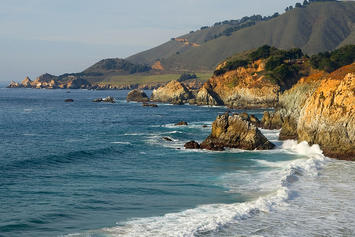
Every now and then, some East Coast based publication sends a reporter out to California to see how the West Coast's economy is doing. I think they write these things sitting at a restaurant patio overlooking the Pacific Ocean. That can be seductive, and lulled into a comfortable sense that all is well with the world, the reporter always gets it wrong.
The most recent example is this New York Times article. The second paragraph summarizes the article:
Communities all along the state’s coastline have largely bounced back from the recession, some even prospering with high-tech and export businesses growing and tourism coming back. At the same time, communities from just an hour’s drive inland and stretching all the way to the Nevada and Arizona borders struggle with stubbornly high unemployment and a persistent housing crisis. And the same pattern holds the length of the state, from Oregon to the Mexican frontier.
The next paragraph contains the mandatory quote from California's favorite economic Pollyanna, Steve Levy:
“This is really a tale of two economies,” said Stephen Levy, the director of the Center for Continuing Study of the California Economy. “The coastal areas are either booming or at least doing well, and the areas that were devastated still have a long way to go. The places that existed just for housing are not going to come back anytime soon.”
The article is accompanied by a photo of a couple driving a red Ferrari convertible. The caption says "Driving through Newport Beach in Orange County. Communities along the coast have largely rebounded from the recession."
This is all nonsense.
There are two reasonable measures of recovery, jobs and real estate values. You can forget the real estate values measure. Values throughout California are down from pre-recession highs. They are down a lot. Only San Francisco and Marin counties, with median home prices down 27.7 percent and 32.3 percent, respectively, have seen net median home price declines of less than 40 percent. Monterey and Madera counties top the state in median home price declines, in excess of 67 percent.
So let's use jobs. An area has recovered if it has as many jobs today as it had at the beginning of the recession, December 2008.
We monitor 37 California MSAs. Combined they represent about 96 percent of California's population. By jobs, only one of California's larger MSAs has recovered, and that county does not fit the story. Not only is Kings County not on the ocean, it doesn't even border or have a naturally occurring year-round piece of water. Kings County, with 37,700 jobs, has about 900 more jobs than it had at the beginning of the recession. Still, Kings County's unemployment rate is 17 percent. Some recovery!
Orange County, which the New York Times article cites as largely rebounded, is down 127,800 jobs from its pre-recession high. That's an 8.5 percent decline. Los Angeles County is down 337,000 or 8.1 percent of jobs. The difference between unemployment rates, 8.0 percent in Orange County versus 12.1 percent in Los Angeles County, reflects different unemployment levels at the beginning of the recession and the high cost of living in Orange County. Most people can't afford to be unemployed long in Orange County. You either find a job, or you leave.
Here are the Counties that have lost, on net, less than 6 percent of jobs in the recession:
County/MSA |
Job gain |
percent change |
Unemployment |
|
Imperial |
-100 |
-0.2% |
26.7% |
|
Kings |
900 |
2.4% |
17.0% |
|
Merced |
-2,800 |
-4.8% |
20.0% |
|
Monterey |
-5,600 |
-4.3% |
15.3% |
|
San Diego |
-66,400 |
-5.1% |
9.3% |
|
San Francisco |
-33,600 |
-3.4% |
8.0% |
|
Santa Clara |
-19,900 |
-2.1% |
8.8% |
|
San Luis Obispo |
-5,900 |
-5.7% |
8.7% |
|
Santa Barbara |
-8,200 |
-4.7% |
8.9% |
|
Santa Cruz |
-3,800 |
-4.1% |
13.6% |
|
Solano |
-6,100 |
-4.8% |
10.9% |
It's hard to find real recovery here. Three of the sub-10-percent-unemployment-rate counties (Marin, San Luis Obispo, and Santa Barbara) are home to the wealthy, those who serve them, and a very small middle class. They have not had and will never have anything like robust economies. Think of them as big Leisure Villages for the terminally fashionable.
That leaves San Diego, San Francisco, San Mateo, and Santa Clara counties as potential vigorous economies. Let's look at these regions' job creation last month. Unfortunately, the data are only available by MSA. San Diego County saw job growth of 1,300 jobs in February, an increase of about 0.11 percent. Santa Clara/San Benito saw job growth of about 4,100, or 0.46 percent. San Francisco/San Mateo/Marin saw growth of about 7,100 jobs, or 0.74 percent.
It looks to me like there is a small island of relative prosperity: San Francisco, San Mateo, and Santa Clara Counties, but even these counties have not fully recovered. This island is indeed on the coast, but it represents just a small fraction of the coastal county population.
The idea that there is some sort of Coastal resurgence in California is just absurd. Certainly, the 593,800 still unemployed in Los Angeles --- by far the state’s most populous --- are not likely to agree that “The coastal areas are either booming or at least doing well..."
Bill Watkins is a professor at California Lutheran University and runs the Center for Economic Research and Forecasting, which can be found at clucerf.org.
California coast photo by BigStockPhoto.com.












